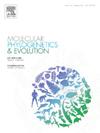Resolving taxonomic uncertainties in ailiid catfishes (Siluriformes: Ailiidae) using Genome-Scale data
IF 3.6
1区 生物学
Q2 BIOCHEMISTRY & MOLECULAR BIOLOGY
引用次数: 0
Abstract
The Ailiidae family, endemic to South and Southeast Asia, comprises diverse freshwater catfish inhabiting major river basins across the region. Evolutionary relationships and taxonomic classification within Ailiidae family remain contentious. Here, we resolve these uncertainties using phylogenomic data from 29 specimens representing 11 species and six of the seven recognized genera, supplemented by two outgroup taxa (Pachypterus atherinoides and P. acutirostris). Hybridization target enrichment and high-throughput sequencing yielded 4,434 single-copy nuclear coding loci. After trimming loci with more than 50 % missing taxa, 2,102 loci, totaling 505,110 bp, were used for phylogenomic analyses. The results confirm monophyly of all studied genera (Ailia, Ailiichthys, Clupisoma, Eutropiichthys, Silonia and Laides), after the reclassification of Clupisoma montanum and C. sinense into the genus Laides, based on concordant molecular, morphological and meristic evidence. Notably, Ailia coila and Ailiichthys punctata formed an early diverging clade, sister to remaining Ailiidae. Furthermore, our results corroborate that the genera Eutropiichthys and Silonia represent distinct lineages within Ailiidae, warranting their formal retention in the family. Divergence dating estimated the most recent common ancestor of Ailiidae arose during the Pleistocene, with a median age of 2.1 million years ago (95 % HPD: 3.34–1.0 Ma). Biogeographic reconstructions identified the Ganges–Brahmaputra River basin (South Asia) as the center of origin for Ailiidae, followed by dispersal to the Irrawaddy–Salween, Pahang and Indus River basins. Pleistocene climatic fluctuations, tectonic uplift and changes in sea-level may have influenced the dispersal of Ailiidae catfishes. These geological events restructured river systems and exposed land bridges, allowing movement across previously isolated basins. Paleo-river connections between the major drainages of South and Southeast Asia likely facilitated multiple events of vicariance and dispersal, driving diversification within the Ailiidae.

利用基因组尺度数据解决麻麻属鲶鱼(siluriforma: Ailiidae)的分类不确定性。
鲶鱼科是南亚和东南亚特有的,由生活在该地区主要河流流域的多种淡水鲶鱼组成。爱丽科的进化关系和分类学分类仍有争议。在这里,我们使用来自29个标本的系统基因组数据来解决这些不确定性,这些标本代表11个物种和7个公认属中的6个,并补充了两个外群分类群(atherinopachypterus和p。acutirostris)。杂交靶富集和高通量测序得到4,434个单拷贝核编码位点。在对超过50% %缺失分类群的位点进行修剪后,共有2102个位点(总计505,110 bp)用于系统基因组分析。基于一致的分子、形态学和分生学证据,在将Clupisoma montanum和C. sinense重新分类为Laides属之后,证实了所有研究属(Ailia、Ailiichthys、Clupisoma、Eutropiichthys、Silonia和Laides)的单系性。值得注意的是,大Ailia coila和斑点Ailiichthys punctata形成了一个早期的分支,是现存Ailiidae的姐妹。此外,我们的研究结果证实了富营养鱼属和silonia属在Ailiidae中代表了不同的谱系,保证了它们在家族中的正式保留。差异定年法估计,Ailiidae最近的共同祖先出现在更新世,中位年龄为210万年前(95 % HPD: 3.34-1.0 Ma)。生物地理重建确定恒河-布拉马普特拉河流域(南亚)是Ailiidae的起源中心,随后扩散到伊洛瓦底江-萨尔温江,彭恒河和印度河流域。更新世气候波动、构造隆升和海平面变化可能影响了鲶鱼的扩散。这些地质事件重组了河流系统,暴露了陆桥,使运动得以跨越以前孤立的盆地。南亚和东南亚主要流域之间的古河流连接可能促进了多种迁移和分散事件,推动了阿利亚科的多样化。
本文章由计算机程序翻译,如有差异,请以英文原文为准。
求助全文
约1分钟内获得全文
求助全文
来源期刊
CiteScore
7.50
自引率
7.30%
发文量
249
审稿时长
7.5 months
期刊介绍:
Molecular Phylogenetics and Evolution is dedicated to bringing Darwin''s dream within grasp - to "have fairly true genealogical trees of each great kingdom of Nature." The journal provides a forum for molecular studies that advance our understanding of phylogeny and evolution, further the development of phylogenetically more accurate taxonomic classifications, and ultimately bring a unified classification for all the ramifying lines of life. Phylogeographic studies will be considered for publication if they offer EXCEPTIONAL theoretical or empirical advances.

 求助内容:
求助内容: 应助结果提醒方式:
应助结果提醒方式:


